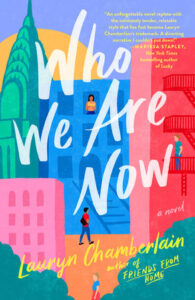In my writing, I often begin a scene by drafting two versions of the same event: the event as it would look captured on camera, the “view from nowhere,” in as much as such a thing can ever exist—and then the scene as witnessed by a primary character. What do they focus on? What is the unique piece they will take away, the piece that someone else might not?
In my first novel, I performed this trick with relative ease. I wrote Friends From Home in singular first person—and from the point of view of a twenty-something woman, who is not me, but to whom I once bore, let’s say, more than a passing resemblance.
When I started my second novel, Who We Are Now, I imagined it as a story of four friends, and I wanted each of their perspectives to carry equal weight. I decided to write in close third-person, multi-POV. Four backstories, four points of view. Because while my first novel “came to me” in first person, I admit that I have a personal preference for a different style: I love sprawling, multi-POV novels. They create complex layers within a story, as well as juicy potential for dramatic irony when readers get a glimpse of something other characters do not know. They’re so like life to me, suffused with a realization that grows with age: that we are not the only players in a story, that there are always secrets yet to be revealed, and perceptions we might never understand even as we are so sure of our own.
I embarked on writing this way with a bit of trepidation, but mostly enthusiasm. I think I estimated that writing from four points of view would be, through simple math, about four times more difficult than writing from one. But I was wrong.
The unexpected math of multi-POV writing
My sense of each of my characters—Rachel, Dev, Clarissa, and Nate—came quite easily. They felt like people I’d met, old college classmates of mine that I’d lost touch with, perhaps, and their extrinsic qualities were clear to me relatively early.
As I started drafting, I embarked on my familiar exercise: writing a pivotal scene—a group ski trip gone wrong—from each of their four POVs, even as I knew the ultimate perspective I wanted to tell it from. Who knew what? Who would perceive which slights in this interaction, whose secrets would be revealed?
And then I realized: Because all four characters are—or had been, at least—close friends, I wasn’t simply handling four different views of the world. I was handling somewhere between six and twelve different relationships.
I didn’t find writing from four points of view four times more challenging than writing from one. It was exponentially so.
Let me explain: Each of the four characters has three close friendships with the others that they perceive in a certain way. Multiplied across each of them, that adds up, in my estimation, to twelve: how Rachel sees Clarissa is different from how Clarissa sees her; so is how Clarissa views Nate, and vice versa, and so on.
This is an interesting point, however, because it does, in a way, depend upon how you see the nature of relationship itself: is a friendship between person A and person B one entity? Or is it, in fact, two? Two perspectives of the other and of the self; two interpretations of the very same lived events? To me, and to anyone who has pursued the exercise of writing the same scene, or the same story, from two different perspectives, I would argue that it will always be the latter.
From that point forward, I didn’t find writing from four points of view four times more challenging than writing from one. It was exponentially so.
Solving the multi-POV proof
To sort out this exponential problem, I started to keep notes.
Who We Are Now spans about fifteen years. Going into each new year, which represents its own section in the novel, I roughly sketched out each characters’ perceptions. For example: leading into 2008, how does each character feel about the others? What concerns do they have? And what—if anything—might they not know or find missing that will come out later?
This note-taking structure—having a series of bullet points at the top of the page to start each chapter—proved incredibly helpful, and never more so than when it came time to change the structure of the book.
After I’d struggled through a first draft, I submitted a version to my brilliant editor, knowing that something was still missing that could help us propel the story forward through the endlessly rotating POVs. As it turned out, she had a structural solution: to divide the book into three sections, each consisting of four years, with one year told linearly from the perspective of each of the characters. (In the first draft, I’d taken a somewhat random approach to shifting POV, so this revision would require me to rewrite a lot of the same events from someone else’s perspective.)
It was an enormous undertaking—but, luckily, I’d done the exercise I described: writing one single scene from each character’s point of view simply so that I’d understand the stakes for all of them. Thus, I already knew how a lot of events looked from someone else’s standpoint; I knew what past relationship or secret a certain character didn’t learn until a point in the future.
The exercise gave me deeper insight and made it possible to embark on the revision—which, I firmly believe, made the book cleaner and more compelling, stronger in just about every way. I recommend this writing trick for every author, regardless of which POV they ultimately select for a scene (or for the story as a whole).
In the end, my editor loved the second draft of Who We Are Now, and so did I. We felt that the multi-POV structure had been well worth keeping, despite all the labor of drafting and revision, and I hope it seems so to the reader as well. I’m proud to have written a novel in this style, and I do believe I will be able to do it better the next time.
Well, eventually. For my next novel, I think I might return to one POV. Or maybe two… after all, I can’t resist the dramatic tension of a good secret.
__________________________________

Who We Are Now by Lauryn Chamberlain is available from Dutton, an imprint of the Penguin Publishing Group, a division of Penguin Random House, LLC.
